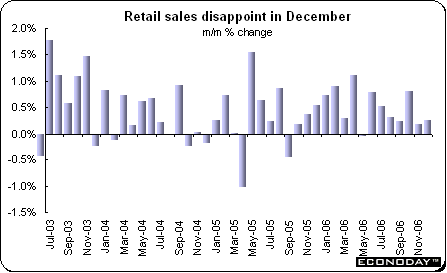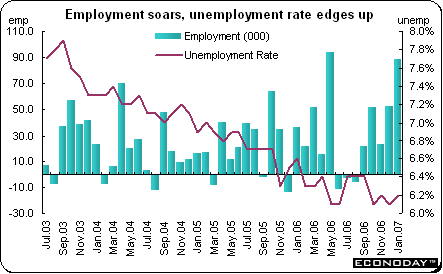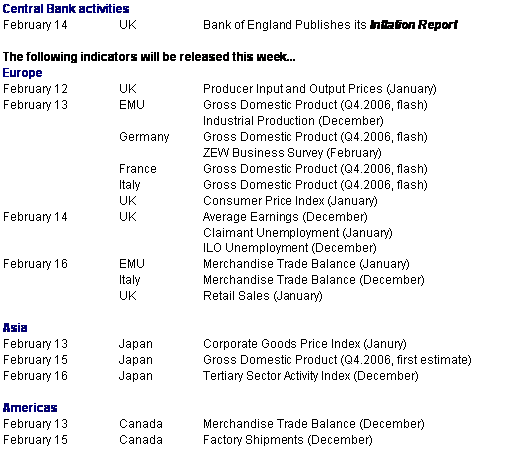European companies (and their governments) will be undoubtedly disappointed after reading the communiqué for the Group of Seven finance ministers and central bankers meeting. The ministers reverted to form and barely changed the wording on foreign exchange from their September 2006 statement. The G-7 includes the U.S., Japan, Germany, the UK, France, Italy and Canada.
U.S. and Japanese officials on one hand and those from Europe on the other differed on whether the yen's weakness should be an agenda item at the two-day meeting in Essen, Germany. The finance ministers from France (Thierry Breton) and Germany (Peer Steinbrueck) said the yen's decline threatens European exports and wanted the matter discussed. But U.S. Treasury Secretary Hank Paulson along with Japanese officials think investors should be free to set currency values free of government interference. In the end, the agenda contained the usual discussion items on financial markets, currencies and the macroeconomic activities of each nation. There was no mention of the yen in the communiqué, but rather refers to Japan's economic growth saying it was on track.
The yen was volatile last week as investors restlessly awaited the meeting's outcome. The communiqué that follows these meetings was the focus of speculation as European officials mounted a campaign to put the yen's weakness in the spotlight. The Japanese currency been under pressure in recent months, hitting multi-year lows against the U.S. dollar, euro and pound sterling as the appetite for carry trades pervaded the market and continued unabated. Carry trades are those in which long positions in high-yielding currencies are funded by selling low-yielding currencies, such as the yen.
China was the only country whose currency was singled out for criticism. The G-7 replaced its prior request for the yuan to show greater flexibility with a demand that it "move" more on a trade-weighted basis to help close imbalances such as between China's trade surplus and the U.S. trade deficit.

Higher and higher they go
World equity markets reached new highs last week despite lingering concerns about global economic growth, inflation and interest rates. While both the Bank of England and the European Central Bank left their key interest rates unchanged, ECB president Jean Claude Trichet upset investors when he used his code words, 'strong vigilance' indicating that the Bank's key interest rate would increase at their March meeting - and more increases could be on the way after that.
In the U.S., the Dow touched a new record high midweek but sagged on Friday. Both the Dow and Nasdaq were down on the week. There were concerns among investors about risky mortgage lending, which in turn rekindled worries about the housing sector. On the week, the Nikkei was down slightly while the four North American indexes followed here were down on the week.
Global Stock Market Recap

Europe and the UK
The FTSE, CAC and DAX were up last week, with the FTSE gaining 1.1 percent while the CAC and DAX edged up 0.3 percent and 0.4 percent respectively. Earnings especially from mining and airline companies triggered the gains. The three continue to set new six year highs but have yet to reach their all-time highs set at the end of 1999 and early 2000. The FTSE is about 8 percent off its all time high while the CAC and DAX are about 15 percent and 11 percent below their highs respectively.

ECB's Trichet - 'strong vigilance'
With the use of his code words 'strong vigilance' at his press conference, ECB president Jean Claude Trichet signaled an interest rate increase in March and left the door ajar for the possibility of more increases to come later in 2007. The ECB's current interest rate is 3.5 percent. Since December 2005 the ECB has increased its key rate six times, each by 25 basis points, with the last one occurring in December 2006.
The ECB has been engaged in a war of words with eurozone politicians, and especially with those in France where presidential elections are scheduled for April. French politicians fear growth prospects have been hit thanks to the euro's strength. Mr Trichet, who stressed the ECB's independence, said he expected inflation to climb again this year because of upside risks from larger-than-expected wage settlements. He said that by making decisions now, the Bank is ensuring price stability in the future. By taking a pre-emptive stance, he sought to deflect critics who point to January's inflation reading of 1.9 percent, just below the ECB's stated inflation ceiling.

Looking past announcement to Inflation Report
The Bank of England left its policy interest rate at 5.25 percent as expected after shocking the markets in January with a surprise 25 basis point increase. However the future path is hazy primarily because analysts are divided on the inflationary outlook as well as the Monetary Policy Committee's reaction to future economic data. The current inflation rate is about 1 percentage point above the Bank's inflation target of 2 percent. The Bank of England does not release a statement when no action is taken. But it was in stark contrast to the ECB's posture of giving a clear message to investors of a probable rate increase in March.
Many economists believe inflationary pressures are now ingrained in the British economy. But a similar number believe that with falling energy prices reducing companies' costs, inflationary pressures are much better contained, even if the economy grows strongly. The disagreements have been heightened by a new uncertainty over how the Bank will react to data. They hope the Bank can explain its thinking in its quarterly inflation report on Wednesday.
Asia/Pacific
Asian/Pacific equities were up last week with the exception of the Nikkei. That index edged down 0.2 percent on the week. Only the Kospi remains below its end of 2006 level. Exporters' stocks fluctuated with the yen. The shares dropped for example, after the yen strengthened to less than ¥120 to the dollar in New York, reducing the value of companies' overseas sales when they are repatriated to Japan. The yen had increased on speculation that European policy makers would criticize Japan's currency at the G-7 meeting. But as expectations of G-7 action on the yen faded, stocks rallied on Friday in relief.

RBA keeps the status quo
The Reserve Bank of Australia left its key interest rate at a six year high of 6.25 percent after consumer prices were down for the first time in eight year. The RBA's three interest rate increases since May 2006 have finally cooled consumer spending. The RBA's inflation target range is between 2 percent and 3 percent. Like the Bank of England it does not release an explanatory statement when no action on rates is taken.

Currencies
Last week's focus was on the yen and its relatively low levels against the U.S. dollar and the euro as speculation faded that the currency would be a focus at the G-7 meeting. Traders were looking for direction from the Group of Seven, but did not get it. In remarks prior to the meeting, U.S. Treasury Secretary Henry Paulson said that Japan is still struggling with deflation and that the yen is trading in a competitive marketplace based on economic fundamentals. The yen has declined about 4.8 percent against the dollar and 5.5 percent versus the euro since August, spurring complaints among some European manufacturers about the impact on exports and stimulus to Japanese goods. Last week, the yen reached its lowest against the dollar since 2002.

Even though the dollar advanced against the euro after concerns about inflation were voiced by two regional Federal Reserve Bank presidents, St. Louis Federal Reserve Bank's William Poole and Federal Reserve Bank of Cleveland's Sandra Pianalto, the currency edged lower against the euro on the week. The Federal Reserve has kept its fed funds target rate at 5.25 percent since August after 17 consecutive quarter-percentage point increases between June 2004 and June 2006. It compares with the European Central Bank's 3.5 percent and the Bank of Japan's 0.25 percent rate, the lowest among industrialized nations.
Indicator scoreboard
EMU - December retail sales were up 0.3 percent and 2.1 percent when compared with last year. German sales in the month prior to the increase in the value added tax (VAT) were up 2.4 percent while those of France and Spain were closed to the 0.3 percent mark.

Germany - December merchandise trade surplus declined to €14.4 billion from €19.1 billion in November. For the year 2006, the surplus was €161.9 billion, up from €158.2 billion in 2005. Imports were up 16.5 percent while exports were up 13.7 percent.

December manufacturers' orders edged down 0.2 percent but were up 6.6 percent when compared with last year. Domestic orders were up 0.2 percent while foreign orders were down 0.4 percent. Consumer goods orders sank 4.9 percent. Foreign consumer goods orders were particularly hard hit - sinking 9.4 percent on the month. Producer goods orders were up 0.3 percent while capital goods orders increased 0.6 percent on the month.

December industrial production excluding construction was down 0.6 percent but up 5.1 percent when compared with last year. Manufacturing output was down 0.7 percent. Investment goods production sank 2.8 percent on the month and dragged the index lower. Most other components were up.

France - December industrial production was up 1.1 percent and 0.7 percent when compared with last year. Manufacturing output was up 1 percent and 1.7 percent on the year. All sectors were up with the exception of consumer goods which edged down 0.1 percent. Semi-finished goods were up 1.4 percent while autos were up 1.2 percent and capital goods, 0.9 percent.

December merchandise trade deficit was €2.9 billion, larger than November's €2.7 billion shortfall. For the year 2006, the deficit jumped by 27 percent and now equals over 3 percent of GDP. However, excluding energy, the trade balance is in surplus. Exports were down 0.8 percent while imports edged down slightly.

Britain - December industrial production edged down 0.1 percent and was up 0.5 percent when compared with last year. The decline was the result of mild winter weather combined with a 3.7 percent dip in the mining and quarrying sector, which includes oil and gas extraction. Manufacturing output however, was up 0.2 percent and 2.4 percent on the year. Production in the food, drink and tobacco industries expanded by 1.2 percent.

December merchandise trade deficit was £4.9 billion compared with a deficit of £4.5 billion in November. The surplus on trade in services was £2.2 billion compared with a surplus of £2.4 billion in November. The deficit on trade in goods was £7.1 billion, compared with a deficit of £6.9 billion in November. Exports were down 1.2 percent while imports edged up by 0.2 percent.

Asia
Australia - December retail sales climbed 0.3 percent and were up 6.3 percent when compared with the same month a year ago.

January employment was down by 3,500 after increasing by 46,000 in December. Full-time employment increased by 3,200 while part-time employment decreased by 6,700. The unemployment rate edged down to 4.5 percent after readings of 4.6 percent for 3 consecutive months. The labor participation rate ebbed downward to 64.8 percent from 65 percent in December.

Americas
Canada - January employment soared by 88,900 jobs primarily on gains in the service sector. Information, culture & recreation added 29,000 jobs, professional, scientific & technical services gained 28,000 and accommodation & food services increased by 24,000. Unemployment rate edged up to 6.2 percent from 6.1 percent as more people entered the labor force. The participation rate hit a record high of 63.4 percent. Full-time employment was up 45,900 while part-time employment was up 42,900.

Bottom line
Last week saw the three central banks that held meetings - Reserve Bank of Australia, Bank of England and European Central Bank - maintain their current interest rate levels at 6.25 percent, 5.25 percent and 3.5 percent respectively. The RBA and Bank of England did not issue statements, however, the ECB indicated that another rate increase was looming. Although the focus of foreign exchange traders is usually on interest rate differentials between countries, anticipation of the Group of Seven communiqué at the meeting's end roiled the currency markets.
Attention turns to growth this week. Flash or first estimates for fourth quarter gross domestic product will be released by most European countries along with Japan. Investors will want to confirm the G-7 statement on Japan's growth.
Looking Ahead: February 12 through February 16, 2007

Anne D Picker is the author of International Economic Indicators and Central Banks.

